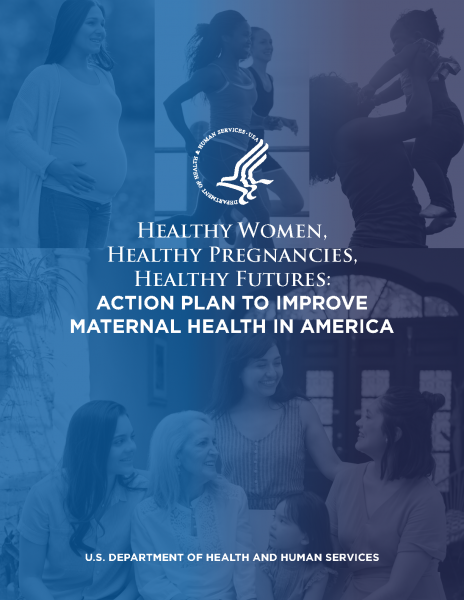The U.S. Department of Health and Human Services (HHS) recently released the HHS Maternal Health Action Plan to reduce maternal deaths and disparities that put birthing people at risk before, during, and following pregnancy.1 The Action Plan provides a roadmap for addressing risk factors before and during pregnancy, improving the quality of and access to maternity and postpartum care, and supporting a research agenda to fill gaps in current evidence.1
It outlines three specific targets to improve the nation’s maternal health outcomes by 2025:
- Reduce the maternal mortality rate by 50%
- Reduce low-risk cesarean deliveries by 25%
- Achieve blood pressure control in 80% of women of reproductive age with hypertension1
In addition, the U.S. Surgeon General Jerome M. Adams issued a Call to Action to Improve Maternal Health, which outlines the critical roles everyone can play to improve maternal health.1
Approximately 700 women die each year in the United States as a result of pregnancy-related complications.2 Every year more than 25,000 women suffer unintended outcomes of labor and delivery that can result in significant short- or long-term consequences to their health.1 Birthing people who belong to Black Indigenous People of Color (BIPOC) communities, specifically American Indian/Alaska Native and Black people are 2 to 3 times more likely to die from a pregnancy-related cause than white women.3 This disparity persists across income and education levels4 and can be attributed to several intersecting factors, including historic racial discrimination in housing, healthcare and other systems that have placed BIPOC birthing people in neighborhoods with poor built environments and little to no access to quality prenatal and postpartum care.5 These factors, among others, create the intersection of chronic stress, sexism, and racism that places BIPOC communities at greater risk for preventable adverse birth outcomes. In recent months, positive birth outcomes were further threatened by COVID-19 protocols that have limited in-person prenatal and postpartum care, which is critical to identifying conditions such as pre-eclampsia and establishing trust between provider and patient.
Local health departments (LHDs) are pivotal in improving health outcomes for pregnant and postpartum people. According to NACCHO’s 2019 National Profile of Local Health Departments, the majority of LHDs provide services to support the health of birthing people, including Women, Infants, and Children (WIC) services (68%), early and periodic screening diagnosis and treatment (38%), prenatal care (30%), and well child clinics (30%).6 The call to action specifically outlines how states, tribal, and local health departments can create the infrastructure and environments that are supportive of maternal health and tailored to local needs and challenges that ensure access to high quality medical care. The call to action specifically highlights strategies on how state, tribal and local health departments can:
- Create social and physical environments that promote good health.
- Provide breastfeeding support at the individual and community levels. This strategy is closely aligned with NACCO’s breastfeeding initiative. NACCHO implements the Reducing Breastfeeding Disparities through Continuity of Care project to develop a national Continuity of Care (COC) blueprint with national partners, provide targeted technical assistance to CDC’s Racial and Ethnic Approaches to Community Health (REACH) grantees in COC and funding Continuity of Care community partnership activities.7 Learn more here.
- Strengthen perinatal regionalization and quality improvement initiatives.
- Promote community-driven initiatives101 and workforce development.
- Ensure a broad set of options for women to access quality care.
- Support evidence-based programs to address health risks before, during and after pregnancy.
- Improve the quality and availability of data on maternal morbidity and mortality.1
NACCHO looks forward to supporting LHDs with the strategies outlined in the Call to Action. The role of LHDs is pivotal in advancing public health and ensuring that all birthing people are safe, healthy and whole, especially those who are disproportionately impacted by adverse birthing outcomes.
“The health of our nation depends on the health of our mothers, and making the U.S. the safest place in the world to give birth is one of my top priorities,” said Vice Adm. Jerome M. Adams, Surgeon General.
References
- U.S. Department of Health and Human Services. (2020, December 2). HHS Outlines New Plans and a Partnership to Reduce U.S. Pregnancy-related Deaths. HHS.Gov. https://www.hhs.gov/about/news...
- Emily E. Petersen et al., “Racial/Ethnic Disparities in Pregnancy-Related Deaths — United States, 2007–2016,” Morbidity and Mortality Weekly Report 68, no. 35 (September 2019): 762–765, https://www.cdc.gov/mmwr/volumes/68/wr/mm6835a3.htm.
- Petersen EE, Davis NL, Goodman D, et al. Racial/Ethnic Disparities in Pregnancy-Related Deaths — United States, 2007–2016. MMWR Morb Mortal Wkly Rep 2019;68:762–765. DOI: http://dx.doi.org/10.15585/mmwr.mm6835a3external icon.
- Panchal, N., Kamal, R., Cox, C., Garfield, R., Hamel, L., Muñana, C., & Chidambaram, P. (2020, August 21). The Implications of COVID-19 for Mental Health and Substance Use. KFF. https://www.kff.org/coronaviru...
- Owens, D. C., & Fett, S. M. (2019). Black Maternal and Infant Health: Historical Legacies of Slavery. American journal of public health, 109(10), 1342–1345. https://doi.org/10.2105/AJPH.2...
- The National Association of County and City Health Officials. (n.d.). National Profile of Local Health Departments - NACCHO. https://www.naccho.org/resourc...
- The National Association of County and City Health Officials. (n.d.). Breastfeeding - NACCHO. https://www.naccho.org/program...



